Prophylactic efficacy of TcVac2 against Trypanosoma cruzi in mice
- PMID: 20706586
- PMCID: PMC2919396
- DOI: 10.1371/journal.pntd.0000797
Prophylactic efficacy of TcVac2 against Trypanosoma cruzi in mice
Abstract
Background: Chagas disease is a major health problem in Latin America, and an emerging infectious disease in the US. Previously, we have screened the Trypanosoma cruzi sequence database by a computational/bioinformatics approach, and identified antigens that exhibited the characteristics of vaccine candidates.
Methodology: We investigated the protective efficacy of a multi-component DNA-prime/protein-boost vaccine (TcVac2) constituted of the selected candidates and cytokine (IL-12 and GM-CSF) expression plasmids in a murine model. C57BL/6 mice were immunized with antigen-encoding plasmids plus cytokine adjuvants, followed by recombinant proteins; and two-weeks later, challenged with T. cruzi trypomastigotes. ELISA and flow cytometry were employed to measure humoral (antibody isotypes) and cellular (lymphocyte proliferation, CD4(+) and CD8(+) T cell phenotype and cytokines) responses. Myocardial pathology was evaluated by H&E and Masson's trichrome staining.
Principal findings: TcVac2 induced a strong antigen-specific antibody response (IgG2b>IgG1) and a moderate level of lymphocyte proliferation in mice. Upon challenge infection, TcVac2-vaccinated mice expanded the IgG2b/IgG1 antibodies and elicited a substantial CD8(+) T cell response associated with type 1 cytokines (IFN-gamma and TNF-alpha) that resulted in control of acute parasite burden. During chronic phase, antibody response persisted, splenic activation of CD8(+) T cells and IFN-gamma/TNF-alpha cytokines subsided, and IL-4/IL-10 cytokines became dominant in vaccinated mice. The tissue parasitism, inflammation, and fibrosis in heart and skeletal muscle of TcVac2-vaccinated chronic mice were undetectable by histological techniques. In comparison, mice injected with vector or cytokines only responded to T. cruzi by elicitation of a mixed (type 1/type 2) antibody, T cell and cytokine response, and exhibited persistent parasite burden and immunopathology in the myocardium.
Conclusion: TcVac2-induced activation of type 1 antibody and lymphocyte responses provided resistance to acute T. cruzi infection, and consequently, prevented the evolution of chronic immunopathology associated with parasite persistence in chagasic hearts.
Conflict of interest statement
The authors have declared that no competing interests exist.
Figures
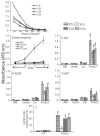
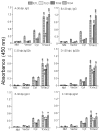
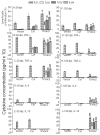
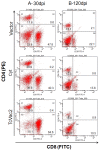
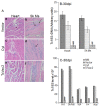
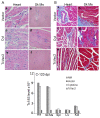
Similar articles
-
Testing the efficacy of a multi-component DNA-prime/DNA-boost vaccine against Trypanosoma cruzi infection in dogs.PLoS Negl Trop Dis. 2011;5(5):e1050. doi: 10.1371/journal.pntd.0001050. Epub 2011 May 17. PLoS Negl Trop Dis. 2011. PMID: 21625470 Free PMC article.
-
Delivery of antigenic candidates by a DNA/MVA heterologous approach elicits effector CD8(+)T cell mediated immunity against Trypanosoma cruzi.Vaccine. 2012 Nov 26;30(50):7179-86. doi: 10.1016/j.vaccine.2012.10.018. Epub 2012 Oct 15. Vaccine. 2012. PMID: 23079191 Free PMC article.
-
Previously unrecognized vaccine candidates control Trypanosoma cruzi infection and immunopathology in mice.Clin Vaccine Immunol. 2008 Aug;15(8):1158-64. doi: 10.1128/CVI.00144-08. Epub 2008 Jun 11. Clin Vaccine Immunol. 2008. PMID: 18550728 Free PMC article.
-
Advances and challenges towards a vaccine against Chagas disease.Hum Vaccin. 2011 Nov;7(11):1184-91. doi: 10.4161/hv.7.11.17016. Epub 2011 Nov 1. Hum Vaccin. 2011. PMID: 22048121 Free PMC article. Review.
-
Immunity and vaccine development efforts against Trypanosoma cruzi.Acta Trop. 2019 Dec;200:105168. doi: 10.1016/j.actatropica.2019.105168. Epub 2019 Sep 9. Acta Trop. 2019. PMID: 31513763 Free PMC article. Review.
Cited by
-
Antigenicity and diagnostic potential of vaccine candidates in human Chagas disease.PLoS Negl Trop Dis. 2013;7(1):e2018. doi: 10.1371/journal.pntd.0002018. Epub 2013 Jan 17. PLoS Negl Trop Dis. 2013. PMID: 23350012 Free PMC article. Clinical Trial.
-
Therapeutic Efficacy of a Subunit Vaccine in Controlling Chronic Trypanosoma cruzi Infection and Chagas Disease Is Enhanced by Glutathione Peroxidase Over-Expression.PLoS One. 2015 Jun 15;10(6):e0130562. doi: 10.1371/journal.pone.0130562. eCollection 2015. PLoS One. 2015. PMID: 26075398 Free PMC article.
-
Accelerating the development of a therapeutic vaccine for human Chagas disease: rationale and prospects.Expert Rev Vaccines. 2012 Sep;11(9):1043-55. doi: 10.1586/erv.12.85. Expert Rev Vaccines. 2012. PMID: 23151163 Free PMC article. Review.
-
Developments in the management of Chagas cardiomyopathy.Expert Rev Cardiovasc Ther. 2015 Dec;13(12):1393-409. doi: 10.1586/14779072.2015.1103648. Epub 2015 Oct 23. Expert Rev Cardiovasc Ther. 2015. PMID: 26496376 Free PMC article. Review.
-
Immune protection against Trypanosoma cruzi induced by TcVac4 in a canine model.PLoS Negl Trop Dis. 2015 Apr 8;9(4):e0003625. doi: 10.1371/journal.pntd.0003625. eCollection 2015 Apr. PLoS Negl Trop Dis. 2015. PMID: 25853654 Free PMC article.
References
-
- Schofield CJ, Jannin J, Salvatella R. The future of Chagas disease control. Trends Parasitol. 2006;22:583–588. - PubMed
-
- Schmunis GA, Yadon ZE. Chagas disease: A Latin American health problem becoming a world health problem. Acta Trop. 2010;115:14–21. - PubMed
-
- Krautz GM, Kissinger JC, Krettli AU. The targets of the lytic antibody response against Trypanosoma cruzi. Parasitol Today. 2000;16:31–34. - PubMed
Publication types
MeSH terms
Substances
Grants and funding
LinkOut - more resources
Full Text Sources
Other Literature Sources
Medical
Research Materials

